What is industrial ventilation?
Ventilation is the mechanical system in a building that brings in "fresh" outdoor air and removes the "contaminated" indoor air.In a workplace, ventilation is used to control exposure to airborne contaminants. It is commonly used to remove contaminants such as fumes, dusts, and vapours, in order to provide a healthy and safe working environment. Ventilation can be accomplished by natural means (e.g., opening a window) or mechanical means (e.g., fans or blowers).
Industrial systems are designed to move a specific amount of air at a specific speed (velocity), which results in the removal (or "exhaust") of undesirable contaminants. While all ventilation systems follow the same basic principles, each system is designed specifically to match to the type of work and the rate of contaminant release at that workplace.
What is the purpose of a ventilation system?
There are four purposes of ventilation:- Provide a continuous supply of fresh outside air.
- Maintain temperature and humidity at comfortable levels.
- Reduce potential fire or explosion hazards.
- Remove or dilute airborne contaminants.
Why have an industrial ventilation system?
Ventilation is considered an "engineering control" to remove or control contaminants released in indoor work environments. It is one of the preferred ways to control employee exposure to air contaminants.Other ways to control contaminants include:
- eliminate the use of the hazardous chemical or material,
- substitute with less toxic chemicals,
- process change, or
- work practice change.
What are the parts of an industrial ventilation system?
Systems are composed of many parts including:- an "air intake" area such as a hood or an enclosure,
- ducts to move air from one area to another,
- air cleaning device(s), and
- fan(s) to bring in outside air and exhaust the indoor contaminated air.
What are the basic types of ventilation systems?
There are two types of mechanical ventilation systems used in industrial settings:Dilution (or general) ventilation reduces the concentration of the contaminant by mixing the contaminated air with clean, uncontaminated air.
Local exhaust ventilation captures contaminates at or very near the source and exhausts them outside.
What are main features of dilution ventilation?
Dilution, or "general", ventilation supplies and exhausts large amounts of air to and from an area or building. It usually involves large exhaust fans placed in the walls or roof of a room or building.Dilution ventilation controls pollutants generated at a worksite by ventilating the entire workplace. The use of general ventilation distributes pollutants, to some degree, throughout the entire worksite and could therefore affect persons who are far from the source of contamination.
Dilution ventilation can be made more effective if the exhaust fan is located close to exposed workers and the makeup air is located behind the worker so that contaminated air is drawn away from the worker's breathing zone. See Figure 1 for examples of good and poor dilution ventilation design.
When used to control chemical pollutants, dilution must be limited to only situations where:
- the amounts of pollutants generated are not very high,
- their toxicity is relatively moderate, and
- workers do not carry out their tasks in the immediate vicinity of the source of contamination.
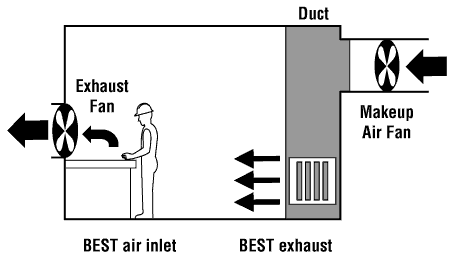
Figure 1
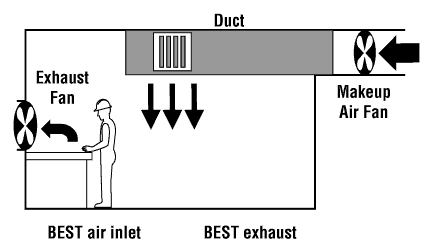
Figure 2
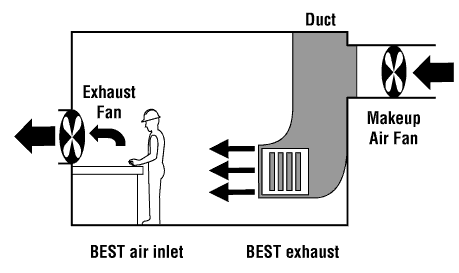
Figure 3
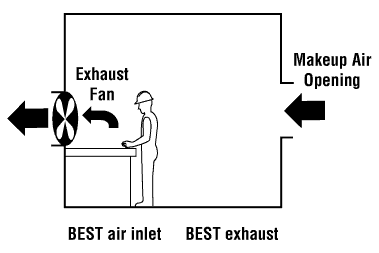
Figure 4
Figures 1 to 4: Examples of recommended dilution ventilation
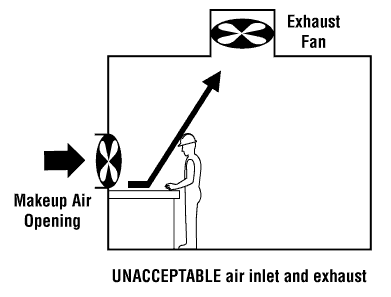
Figure 5
Example of not recommended dilution ventilation
What are the limitations of dilution ventilation?
As a method for protecting workers, it is important to know that dilution ventilation:- Does not completely remove contaminants.
- Cannot be used for highly toxic chemicals.
- Is not effective for dusts or metal fumes or large amounts of gases or vapours.
- Requires large amounts of makeup air to be heated or cooled.
- Is not effective for handling surges of gases or vapours or irregular emissions.
As a general note, the air or "volumetric" flow rate of dilution ventilation depends largely on the how fast the contaminant enters the air as well as the efficiency that fresh air mixes with workroom air.
What is local exhaust ventilation?
Local exhaust system is used to control air contaminants by trapping them at or near the source, in contrast to dilution ventilation which lets the contaminant spread throughout the workplace. Local exhaust is generally a far more effective way of controlling highly toxic contaminants before they reach the workers' breathing zones. This type of system is usually the preferred control method if:- Air contaminants pose serious health risk.
- Large amounts of dusts or fumes are generated.
- Increased heating costs from ventilation in cold weather are a concern.
- Emission sources are few in number.
- Emission sources are near the workers' breathing zones.
What are the components of local exhaust ventilation?
A local exhaust system has six basic elements (see Figure 6):- A "hood" or opening that captures the contaminant at the source.
- Ducts that transport the airborne chemicals through the system.
- An air cleaning device that removes the contaminant from the moving air in the system (not always required).
- Fans that move the air through the system and discharges the exhaust air outdoors.
- An exhaust stack through which the contaminated air is discharged.
- Make up air that replaces the exhausted air.
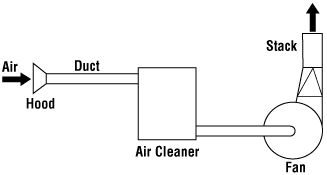
Figure 6
Basic components of a local exhaust system
How do I know which type of ventilation system is best for my workplace?
All industrial ventilation systems, when designed properly, should be able to provide long-term worker protection. The two types of ventilation, dilution and local exhaust, are compared in the following table.| Comparison of Ventilation Systems | |||
|---|---|---|---|
| Dilution Ventilation | Local Exhaust Ventilation | ||
| Advantages | Disadvantages | Advantages | Disadvantages |
| Usually lower equipment and installation costs. | Does not completely remove contaminants. | Captures contaminant at source and removes it from the workplace. | Higher cost for design, installation and equipment. |
| Requires less maintenance. | Cannot be used for highly toxic chemicals. | Only choice for highly toxic airborne chemicals. | Requires regular cleaning, inspection and maintenance. |
| Effective control for small amounts of low toxicity chemicals. | Ineffective for dusts or metal fumes or large amounts of gases or vapours. | Can handle many types of contaminants including dusts and metal fumes. | |
| Effective control for flammable or combustible gases or vapours. | Requires large amounts of heated or cooled makeup air. | Requires smaller amount of makeup air since smaller amounts of air are being exhausted. | |
| Best ventilation for mobile or dispersed contaminant sources. | Ineffective for handling surges of gases or vapours or irregular emissions. | Less energy costs since there is less makeup air to heat or cool. | |
In general, what are limitations of any ventilation system?
Some limitations include:- The systems deteriorate over the years because of to contaminant build-up within the system, especially filters.
- Require ongoing maintenance.
- Regular and routine testing is needed to identify problems early and implement corrective measures.
- Only qualified persons should make modifications to a ventilation system to make sure the system continues to work effectively.
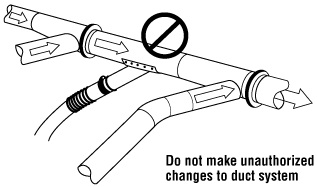
Figure 7
Adding a duct branch
What should I know about make-up air?
An important and sometimes overlooked aspect of local ventilation is the need to provide enough air to replace the air that is exhausted from the workplace. If enough make-up air is not provided when large volumes of air are exhausted, the workplace becomes "starved" for air and negative pressure is created.Negative pressure in the workplace increases resistance on the ventilation system causing it to move less air. Air will also enter a building through cracks around doors or windows or other small openings to try to "equal" the rate of air being removed. The result is that workers may be exposed to cold air in the winter, and additional heating costs may occur. One simple way to judge if a building is under an excessive negative pressure is if you have difficulty opening a door that pushed into the room or building (the air wants to force the door closed).
A separate intake fan, located away from the exhaust fans, should be used to bring in fresh, uncontaminated air from outside. This air must be clean and heated in winter or cooled in summer, as needed.
This post is extremely radiant. I extremely like this post. It is outstanding among other posts that I’ve read in quite a while. Much obliged for this better than the average post. I truly value it! hvac manufacturing companies
ReplyDelete"Wow, I came to learn about industrial ventilation, and your information is absolutely amazing! For more insights and if your are looking for the veeaarengineering! We specialize in reliable solutions to meet all your industrial needs. Keep up the great work!"
ReplyDelete